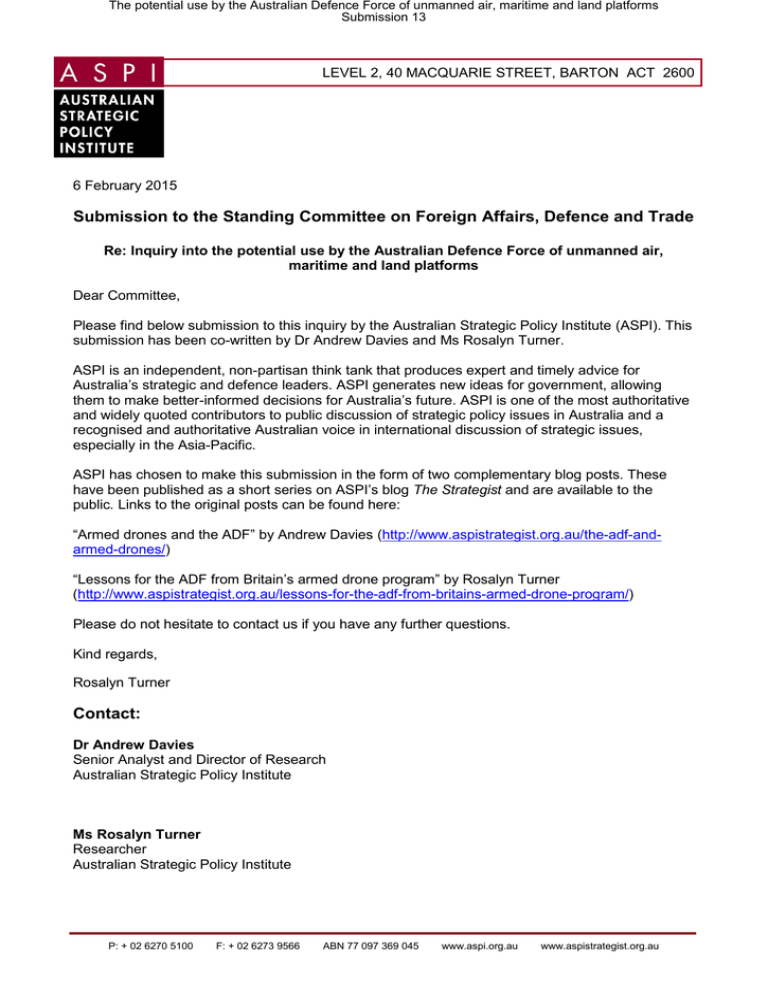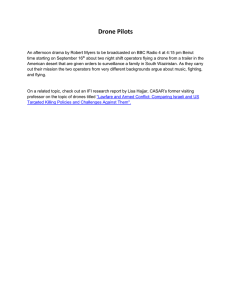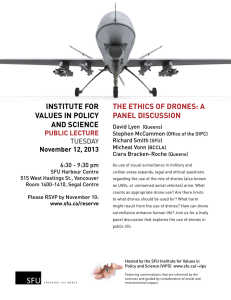LEVEL 2, ARTS HOUSE, 40 MACQUARIE STREET, BARTON ACT
advertisement

The potential use by the Australian Defence Force of unmanned air, maritime and land platforms Submission 13 LEVEL 2, 40 MACQUARIE STREET, BARTON ACT 2600 6 February 2015 Submission to the Standing Committee on Foreign Affairs, Defence and Trade Re: Inquiry into the potential use by the Australian Defence Force of unmanned air, maritime and land platforms Dear Committee, Please find below submission to this inquiry by the Australian Strategic Policy Institute (ASPI). This submission has been co-written by Dr Andrew Davies and Ms Rosalyn Turner. ASPI is an independent, non-partisan think tank that produces expert and timely advice for Australia’s strategic and defence leaders. ASPI generates new ideas for government, allowing them to make better-informed decisions for Australia’s future. ASPI is one of the most authoritative and widely quoted contributors to public discussion of strategic policy issues in Australia and a recognised and authoritative Australian voice in international discussion of strategic issues, especially in the Asia-Pacific. ASPI has chosen to make this submission in the form of two complementary blog posts. These have been published as a short series on ASPI’s blog The Strategist and are available to the public. Links to the original posts can be found here: “Armed drones and the ADF” by Andrew Davies (http://www.aspistrategist.org.au/the-adf-andarmed-drones/) “Lessons for the ADF from Britain’s armed drone program” by Rosalyn Turner (http://www.aspistrategist.org.au/lessons-for-the-adf-from-britains-armed-drone-program/) Please do not hesitate to contact us if you have any further questions. Kind regards, Rosalyn Turner Contact: Dr Andrew Davies Senior Analyst and Director of Research Australian Strategic Policy Institute Ms Rosalyn Turner Researcher Australian Strategic Policy Institute P: + 02 6270 5100 F: + 02 6273 9566 ABN 77 097 369 045 www.aspi.org.au www.aspistrategist.org.au The potential use by the Australian Defence Force of unmanned air, maritime and land platforms Submission 13 The ADF and armed drones By Andrew Davies Today is the last day for submissions to the Foreign Affairs, Defence and Trade References Committee inquiry into the potential use by the Australian Defence Force of unmanned air, maritime and land platforms. The Strategist will publish two posts today on armed drones, which together form ASPI’s open submission to the Committee. When looking at the future shape of the ADF, one of the possible force structure changes the government might chose to make is the addition of armed drones. There are some good reasons for that to happen, but also potential diplomatic downsides that would need to be managed. Let’s start with the case for adding armed drones to the ADF’s inventory. There’re two obvious roles for them to play. The first is armed reconnaissance—being able to survey the battlefield and the wider environment, with the ability to engage the enemy if necessary. This is the same role as envisaged for the Tiger helicopter. The ADF has already used drones for tactical observation purposes in the form of the small Shadow that has a wingspan of just over 6 metres and larger Heron, with a wingspan of 16.6 metres. However neither drone is capable of delivering weapons and any targets identified have to be engaged by other platforms, such as by calling in an air strike. In Afghanistan, the ADF didn’t have its own strike platforms in theatre, and relied on armed helicopters and fixed-wing strike aircraft supplied by other coalition nations. Something like a Reaper with a Hellfire missile is the obvious option for the time being. They’re a weapon that’s suited to the operations the ADF has been undertaking in the past decade and a half; against determined but relatively poorly-equipped adversaries such as the Taliban in Afghanistan. By having its own armed drones, Australian forces would have the capability unilaterally to identify and strike targets. The second application of armed drones is as flying fire support for land force elements that find themselves under fire or otherwise in danger. The long endurance of drones, along with their relatively low cost per flying hour compared to fast jets, makes them a good fit for the role and allows them to be deployed to theatres with relatively limited ability to support flying operations. In a more contested environment in which the adversary has a sophisticated anti-air capability, something more capable than Reaper would be required. For now, that would likely be a manned strike platform with support from electronic warfare and situational awareness platforms. In the future, there’s likely to be higher performance (and almost certainly higher cost) unmanned options such as the stealthy Unmanned Combat Aerial Vehicles under development, such as the American X-47B and European Taranis or nEUROn systems. In fact, when the Defence project that’s acquiring Australia’s F-35 Joint Strike Fighters was conceived, the final phase allowed for the possibility of acquiring high-performance strike drones if their maturity allowed. They simply aren’t yet at a level of technical maturity for that to happen. (And in fact we’re still waiting on the F-35 to reach an operational level of capability, but that’s another story.) Like all acquisitions, it’s a matter of looking at the utility of an armed drone system and comparing it to the cost to make a judgment about its value. But because of the way that armed drones have entered the public consciousness as weapons in the unconventional part of the ‘war on terror’, they’ve the potential to draw opposition from the public and from neighbouring governments. In particular, drone strikes in places like Pakistan and Yemen—countries that aren’t even declared theatres of conflict—have given them a dark mystique that transcends their actual capability. So if Australia was to purchase Reapers or a similar system, there’s the potential to cause alarm, among both Australians and our neighbours. For example, P: + 02 6270 5100 F: + 02 6273 9566 ABN 77 097 369 045 www.aspi.org.au www.aspistrategist.org.au The potential use by the Australian Defence Force of unmanned air, maritime and land platforms Submission 13 Indonesia might be concerned that Australia was planning to conduct its own strikes against extremist groups on its territory. There are two things Australia could do to allay those concerns. Firstly, it could make clear public statements about the concept of operations for the drones, limiting them to use in areas where other ADF elements are deployed, for example. Secondly, and perhaps more importantly, the Australian government could ensure that armed drones are put unambiguously and visibly under military control, rather than being ‘national assets’ in the sense that CIA-operated aircraft that carry out many of the strikes overseas are. Those constraints wouldn’t limit their utility to the ADF, and Australia’s intelligence agencies don’t have the same operational licence that the CIA has. That’s an important difference; the CIA has an operations division (known as the Special Activities Division) as well as an intelligence division, whereas Australia’s Intelligence Services Act explicitly limits the activities of its foreign intelligence agencies to the collection, analysis and dissemination of intelligence. Military or paramilitary activities are explicitly forbidden, and the use of armed drones by civilian agencies would be a dramatic departure from current practice requiring legislative change. By making those arrangements clear, the Australian government could ease any regional apprehension about any future acquisition of an armed drone capability. And as Rosie Turner will show in a follow-on post, the UK’s experience in acquiring and using armed drones shows how we might manage the issue. Andrew Davies is senior analyst for defence capability and director of research at ASPI. P: + 02 6270 5100 F: + 02 6273 9566 ABN 77 097 369 045 www.aspi.org.au www.aspistrategist.org.au The potential use by the Australian Defence Force of unmanned air, maritime and land platforms Submission 13 Lessons for the ADF from Britain’s armed drone program By Rosalyn Turner The Foreign Affairs, Defence and Trade References Committee today closes the window for public submissions on the potential use by the ADF of unmanned air, maritime and land platforms. Following the success of the Scan Eagle, Shadow and Heron drones in a variety of intelligence, surveillance and reconnaissance (ISR) tasks in Afghanistan, one of the key questions the committee should consider is the implications of future Australian acquisition of armed drones. A relatively small group of militaries currently use armed unmanned aerial vehicles (UAVs) in military operations: Israel, the UK and the US. While Israel and the US have expansive indigenous programs that produce their fleets of strike drones, the UK has acquired a small fleet of Americanmade General Atomics MQ-9 Reaper armed drones for the Royal Air Force (RAF). As Andrew Davies outlines in his post, there’re some good reasons for the Australian Defence Force (ADF) to consider armed drones, and the Reaper’s one viable option. The UK’s experience acquiring and integrating the platform into its air force offers some valuable insights and lessons for the ADF, outlined below. Armed drones don’t need to erode targeting laws and processes One of the major concerns that surrounded the UK’s acquisition of Reapers was that the platform might reduce the threshold for military intervention and the use of lethal force because of the lack of physical risk to personnel. For some, that concern has been heightened by the widespread use of drone strikes by the US outside traditional battlefields. But—unlike the US—the UK has restricted the use of armed UAVs to the RAF (rather than its intelligence agencies) and has used them only within the confines of military operations. That means RAF rules of engagement (ROE) that apply for manned aircraft apply equally for Reaper operations. The ADF’s policy on targeting is also tied closely to Australia’s obligations under the laws of armed conflict. If the ADF acquires armed UAVs, restricting the platforms to military operations (as the UK has done) would help alleviate some of the primary legal concerns about their use. Embrace transparency, manage perceptions The UK has made an effort to embrace transparency around its use of Reapers in military operations, most likely to allay speculation that it conducts covert strikes that have proven unpopular for the US. The UK has made data available on Reaper strikes and the Ministry of Defence (MoD) and British government have publicly answered questions about their use through formal inquiry (PDF, also see here). The MoD has also conducted a PR campaign by supporting media events intended to ‘dispel some of the myths that surround the use of UAVs’ and raise awareness of how it uses the technology. Any acquisition of armed drones by Australia, particularly if US-made Reapers are chosen, could ignite similar concerns that they may be used covertly beyond battlefields. As Andrew observed, this is a risk in the case of neighbouring countries, particularly those that are dealing with armed Islamic groups. It’d therefore be wise for Government to be proactive and clear in its public messaging as to where, and how, armed drones would be used. Be prepared to use them…a lot Since the UK acquired its first five Reapers back in 2007 under an urgent operational requirement, the fleet has seen constant action—in Afghanistan up until 2014, and now in Iraq and Syria. In Afghanistan, the UK reportedly conducted up to 40% of the total drone strikes in 2011. One of the issues arising from such a high operational tempo has been maintaining capacity to resource the platforms. The UK’s Select Committee on Defence highlighted a lack of UAV operators and P: + 02 6270 5100 F: + 02 6273 9566 ABN 77 097 369 045 www.aspi.org.au www.aspistrategist.org.au The potential use by the Australian Defence Force of unmanned air, maritime and land platforms Submission 13 imagery analysts as a key challenge shortly after the Reapers began operations. (The US Air Force (USAF) has also struggled in this regard.) It’s hard to predict whether an Australian fleet would see as much action, and it would of course depend on the number and type of operations to which the ADF was committed. Nevertheless it’s been reported that there’s currently a shortage of drones available to confront the challenges in Iraq and Syria, which suggests they’ll remain a sought-after capability for some time. If the ADF decides to acquire these platforms, it’d be well placed to start the process of recruiting and training personnel early to head off challenges faced by the RAF and USAF. The UK’s use of drone strikes may not have garnered as much attention as the widespread actions of the US. Yet in many ways the UK’s more limited use of armed drones has shown how successful this approach can be. The UK’s experience integrating a small but active Reaper fleet into its defence force demonstrates some useful lessons for the ADF, which are made all the more relevant by our other similarities—including our approach to ROE, the role of intelligence services, and our core alliances with the US. Rosalyn Turner completed ASPI’s internship program. P: + 02 6270 5100 F: + 02 6273 9566 ABN 77 097 369 045 www.aspi.org.au www.aspistrategist.org.au


